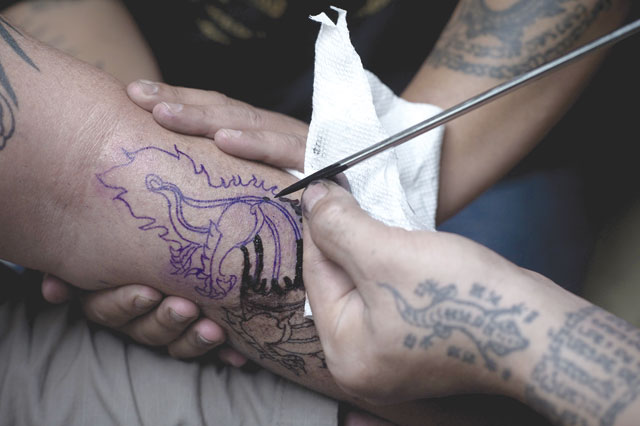BANGKOK — In a cramped Bangkok room filled with statues of deities and plumes of incense smoke, a master is at work.
With expert precision Ajarn Neng repeatedly plunges a razor sharp needle dipped in black ink into the back of a disciple, each stab producing a perfectly placed pixel that forms a traditional Thai tattoo.
It is an ancient art carried out by ajarns (masters), steeped in superstition that Thais have prized for centuries. But increasingly it is foreigners beating a path to this Buddhist tattooist’s door.
“I’ve been dreaming of getting a tattoo like this for years,” says Silvia Falbo, from Rome, proudly showing five lines of Khmer script Neng recently inked onto her shoulder blade.
“I’m attracted to Buddhism and all the spirituality that goes with it. And the design is really beautiful and original,” she adds.
Ever since American GIs passed through Bangkok for their R&R during the Vietnam war foreigners have returned home sporting traditional Thai tattoos — known as “sak yant”.
But it was when Hollywood actress Angelina Jolie unveiled a Khmer inscription — traditionally used in the region for Buddhist scripture — on her left shoulder that sak yant hit the mainstream.
Now the faces patiently waiting for their turn in front of Neng are just as likely to be from outside Thailand than inside.
‘Lacks respect’
But foreign enthusiasm for exotic Thai ink is not without its controversies.
While tattoos in the West are largely an aesthetic decision, in Thailand they are imbued with both spirituality and superstition.
Those who wear sak yant often believe their tattoos genuinely lend them magical powers, bringing good luck or protection from evil spirits. Some are even convinced that their inking will make them bullet proof.
The designs — lines of script, geometric patterns and animal shapes — are also deeply interwoven with Buddhist and animist imagery that some Thais fear Westerners fail to appreciate.
Tattoos showing religious deities such as the Buddha or the Hindu god Ganesh — also popular in Thailand — are particularly problematic, especially if they are below the waist.
In Thai culture, the head is the most sacred part of the body. The further down the body, the less sacred, and foreigners with religious figures inked on their legs have caused upset.
On the main highway into Bangkok from the city’s Suvarnabhumi Airport, huge 15-metre wide billboards declare “It’s wrong to use Buddha as a decoration or tattoo”.
Some groups want a complete ban on any tattoos of religious figures.
“The Buddha was a person who was clean from inside to outside. His mind was free from illusion and all the impurities,” Manat Chareekote, a spokesman for the Knowing Buddha Organisation, told AFP.
“To tattoo the clean one like Buddha on the body is considered improper and lacks respect.”
Power of tattoos
Professor Sukanya Sujachaya, adviser and former director of the Centre of Folklore Research at Chulalongkorn University in Bangkok, believes foreigners should do more research before opting for such tattoos.
“Today it’s about fashion. But this type of tattoo cannot be sold just for their beauty. It also has to be for the belief,” she told AFP.
Thailand is not the only Buddhist country to experience a backlash against foreigners appropriating religious imagery.
In April 2014 a British nurse was thrown out of Sri Lanka for sporting a tattoo of Buddha on her arm despite her insistence she was a devout Buddhist who bore the tattoo as a mark of respect.
And in March Myanmar jailed a New Zealand bar manager for using an image of Buddha wearing headphones to advertise a cheap drinks night.
But while many foreign tourists have little idea about the spiritual significance attached to religious tattoos, others deny being insensitive and say their inkings are more than a fashion statement.
“When I see at my tattoos, it helps me and I think back to what my ajarn told me,” said Logan, an American living in Thailand. “I’ve finally found a perfect ajarn for me. He is really a big brother, he is like a mentor.”
When a follower of an ajarn receives a tattoo, they are often told by their master to follow a certain set of rules to improve their life, with the warning added that failure to do so invalidates the power of the tattoo.
Among the rules are the first five Buddhist precepts — do not harm living beings, do not steal, do not have inappropriate sexual behaviour, do not lie and do not consume drugs or intoxicating liquor.
Neng says many of those visiting him are thinking beyond the look of tattoos.
“Foreigners like the unique beauty of patterns,” he says. “But also, they have learnt that believing in the sacred letters of the tattoo might bring them strength.”
